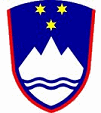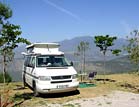 SLOVENIA
- 30 years on
SLOVENIA
- 30 years on
This week's Photos Bottom of page
Return to Index-page
|
As you can see from the map, we have now crossed the Continent with 2 overnight stops, again using campsites at Brodenbach in the Mosel valley and Bad Felnbach in Bavaria. This time however, we continued eastwards from Munich to Salzburg, and then south through the Alps by means of the 5 miles long Karawanken tunnel from Austria into north Slovenia and finally to Ljubljana, the capital city. The consistently dull and wet weather of the last month continued unabated all across the Continent. But as we emerged from the Alpine tunnel into Slovenia, bright sun greeted us and there ahead, the triple peak of Triglav stood clear of the cloud - we hoped this was an omen for fine weather for our Slovenian venture. <Click on
map to show enlarged Slovenian map>
Before setting off into the rural corners of the country, we wanted to spend a few days exploring Ljubljana, Slovenia's capital. Avtocamp Ježica on the northern outskirts of the city has been crowded at this time of the year with tents, campers and caravans from virtually every European country. Ljubljana is a gem of a city, delightfully compact for walking around its many attractions. With only 300,000 inhabitants (smaller than Leicester), it must be Europe's smallest capital city, which is one of its attractions. The city began life as Emona, a Roman military encampment and trading oppidum on the banks of the River Ljubljanica, which still meanders gracefully through the modern city (see Photo 1). The city also retains an architectural legacy of its 700 year Austrian-Habsburg rule, with its richly ornate Baroque churches and wealthy town houses (see Photo 2 of the interior of St Nikolaj Cathedral). In 1895, a devastating earthquake destroyed much of Ljubljana, creating an opportunity for Slovenia's great architect and urban planner Jose Plečnik to adorn the rebuilt city with a flourish of Art Nouveau buildings, bridges, monuments, and riverside embankments (see Photo 3). This was the jewel of a city which we set off to explore on Wednesday morning. Another of Ljubljana's assets is its clean, reliably efficient and extensive bus service. Each journey costs around 55p and you buy tokens (žetoni) at kiosks, shops and at the campsite. We caught the bus outside the campsite for the 10 minute ride into the city centre. Ljubljana is a delightfully compact and civilised place to spend time - so many bookshops in such a small area. The local people are relaxed, courteous and helpful; we never experienced that surliness so often associated with the Balkans. There does feel a self-assured and prosperous air, particularly with the trendily dressed youngsters. It is amazing to realise it is only 12 years since the country asserted its independence in a virtually bloodless secession from the Communist-led Yugoslav Federation in 1991/2. We stood in Republic Square by the Parliament Building, where on 26 June 1991, President Milan Kučan (himself a 'reformed' Communist!) unfurled the new Slovene flag and proclaimed his country's independence with the words "This evening dreams are allowed, tomorrow is another day". Milosovič's Serbian tanks were already moving along the border, but the Slovenian army put up a spirited defence, and after a 10 day stand-off and EEC diplomatic intervention, the Yugoslav army unexpectedly withdrew. Slovenia's full independence followed several months later, with the first multi-party democratic elections being held in December 1992. And here we were, 12 years later, stepping off the bus in Slovenska cesta. Ljubljana is a bright, clean city, one of the least ethnically diverse capitals of Europe, which perhaps explains why it suffers from few of the problems which plague other larger cities - and certainly far less overwhelmed with traffic. We felt perfectly safe and at home, walking around the delightful city centre, mingling with Slovenians going about their daily business. Apart from unsightly graffiti and the occasional wino, we saw nothing to offend or intimidate - where else these days can you say that? There are so many charming squares, such as the beautiful tree-lined Kongresni trg. The central square is Prešeren trg, named after the country's 19th century nationalistic poet France Prešeren. His statue graces the corner by the gently curving River Ljubljanica, which is spanned by the elegant Triple Bridge, another of Plečnik's masterpieces (see Photo 3). The small square seems to embody all the city's charms: a lively atmosphere (definitely the place to be - hence this week's music) with open-air cafés and street musicians; the enormous Baroque Church of the Annunciation, and surrounded by superbly impressive Art Nouveau buildings from the early 20th Century rebuilding period. Not the least of these is Centromerkur, the city's oldest department store which, with its ornate clam-shell entrance canopy, ornate staircase and galleries, and polished wooden furnishings, was like stepping back in time to the 1950s of our childhood. Across the river, it was a joy to wander through the cobbled streets of the Old Town - Mestni trg with its elegant fountain and 18th century Town Hall, Stari trg with its trendy shops topped by fascinating Art Nouveau frontages, and Gornji trg leading up to St Florian's church and the castle on the hill above. But what particularly drew us were the flourishing markets near to St Nikolaj Cathedral in Pogačarjev and Vodnikov trgs, where we bought fish, meat, bread, fruit and vegetables (see Photo 4). Another Plečnik masterpiece is the magnificent Market Colonnade, an elongated pavilion of shops and stalls which follows the curve of the river embankment. All of this market shopping brought the challenge of using the currency - the Slovene Tolar, abbreviated to 'Sit'. There are around 335 Sits to the pound, and getting the number of noughts right when mentally converting 1,200 Sits for your bag of veg, tested the brain. But unusually, the stallholders were very tolerant of those from the euro-zone! It is unusual for us to spend time walking city streets, but without doubt, we have enjoyed a thoroughly delightful 3 days exploring Ljubljana - we highly recommend it as a city for others to visit. But the time has come now for us to set off on our travels, firstly to the small Mediaeval town of Kamnic (only 12 kms to the NE in this bijou country) and the beautiful Logar and Upper Savinje Valleys in the Savinje Alps. More of this in the next report in around 2 weeks. Sheila and Paul Published: 31 July 2004
|

